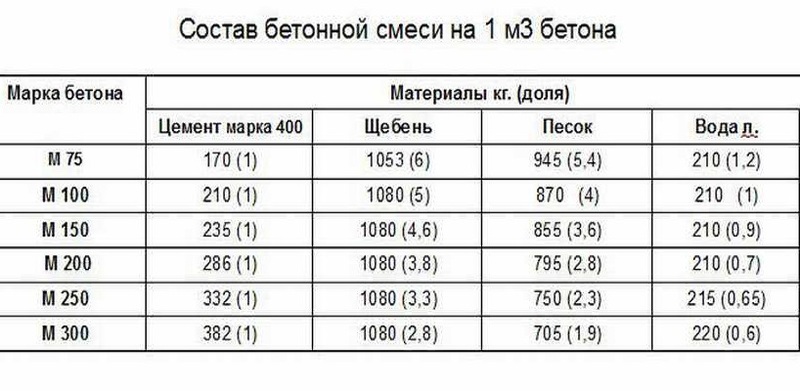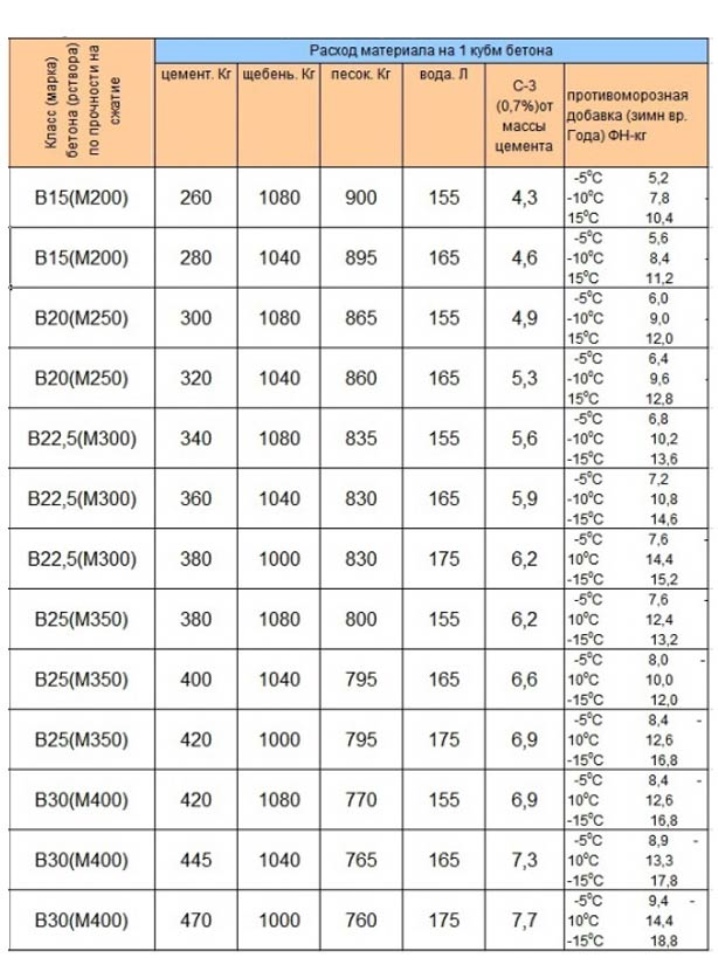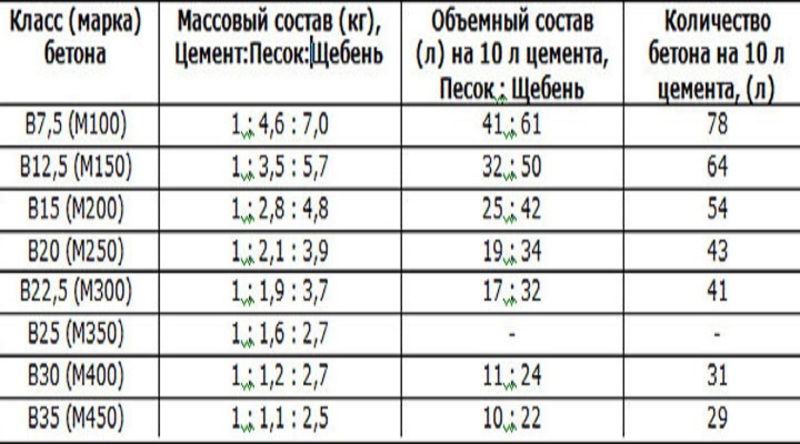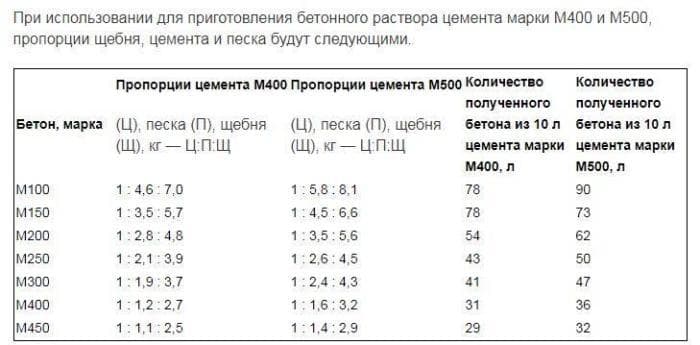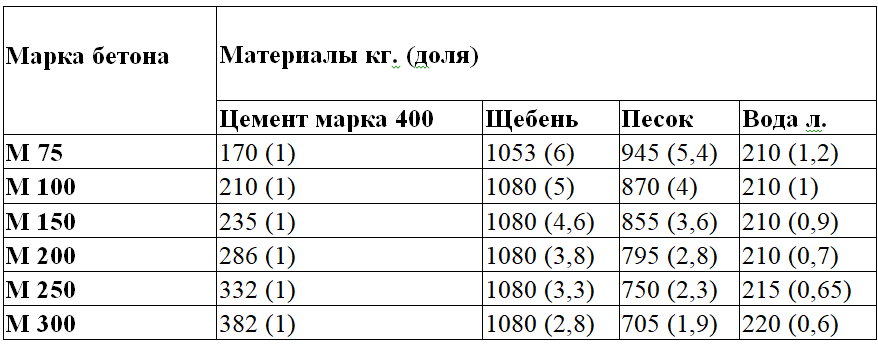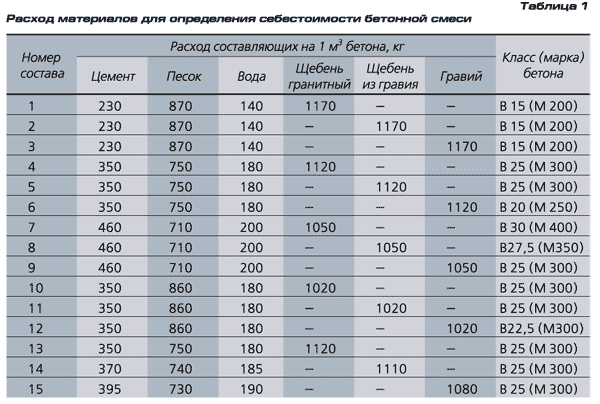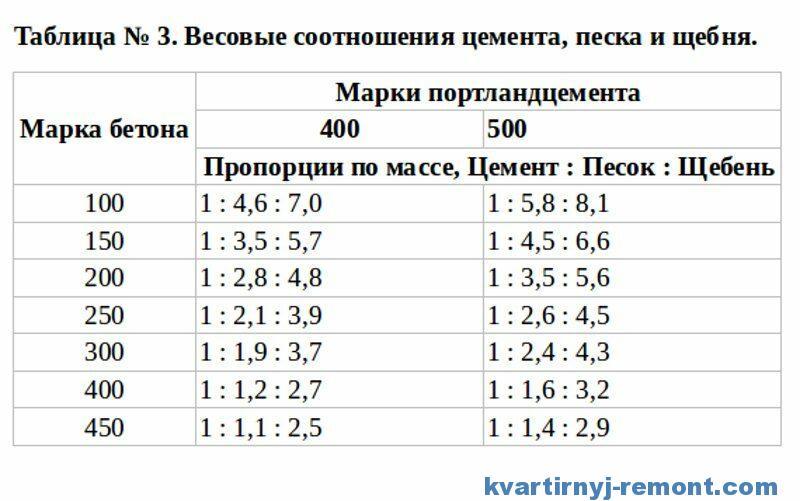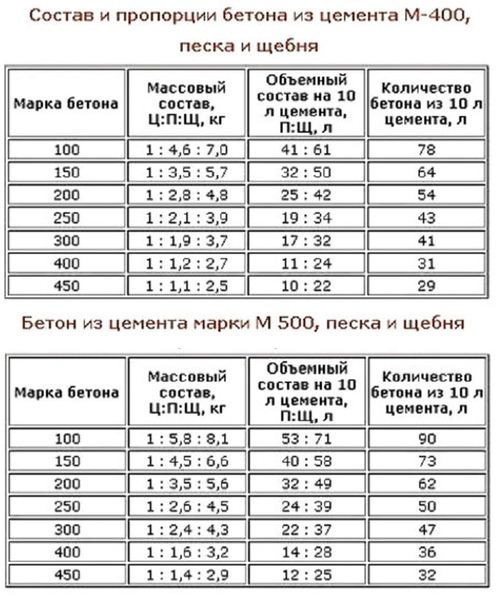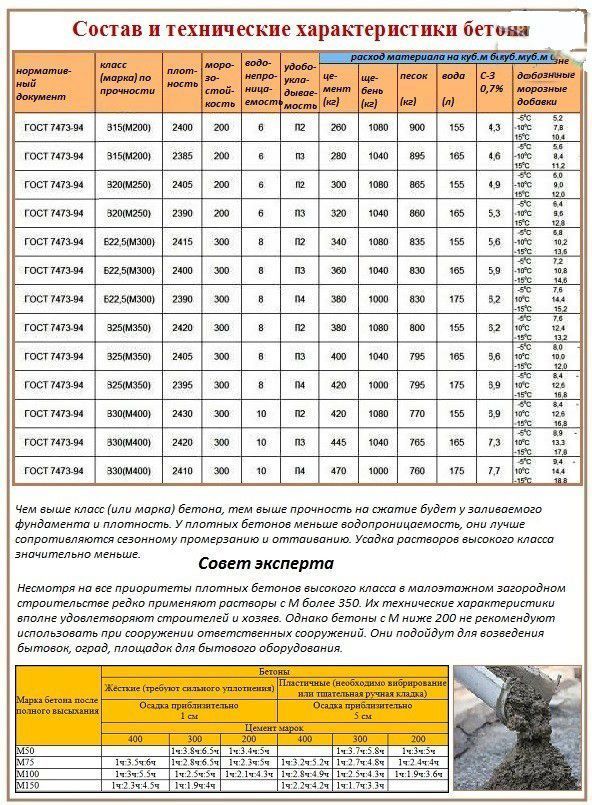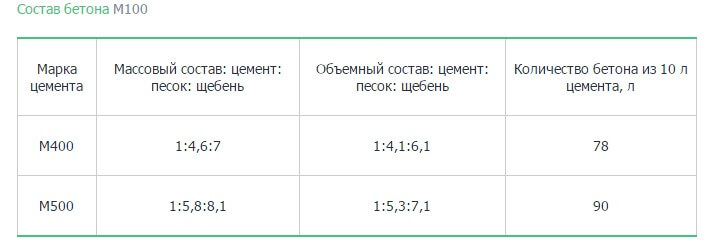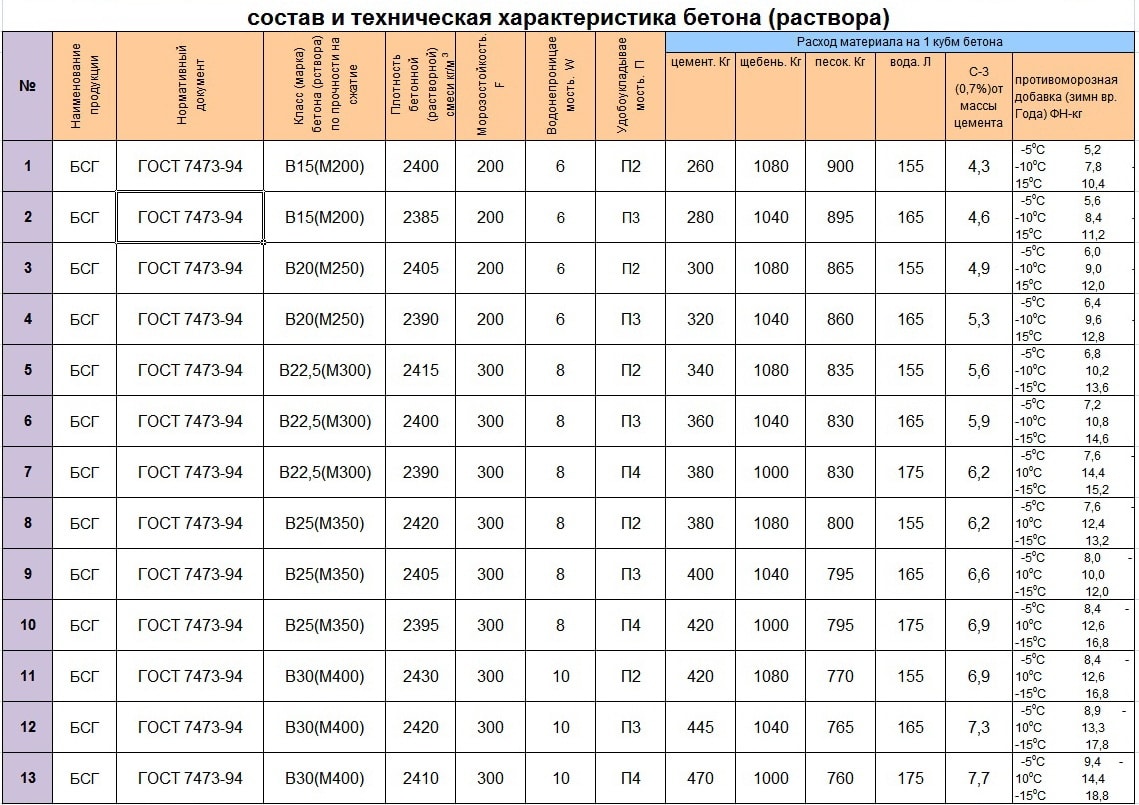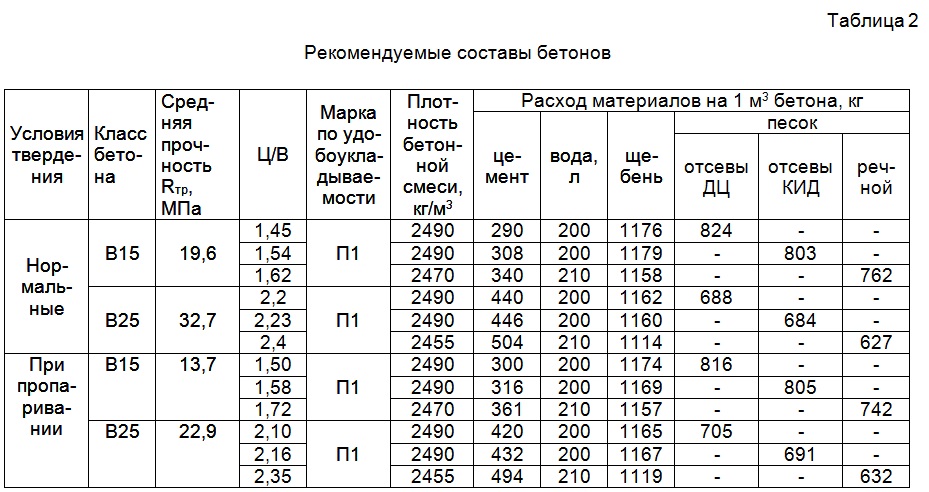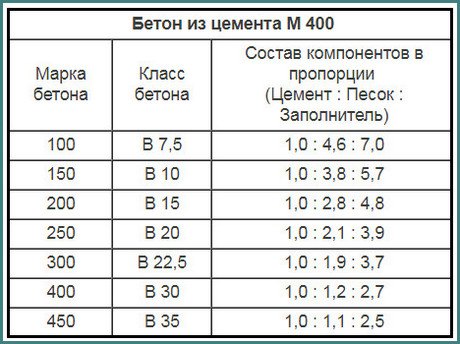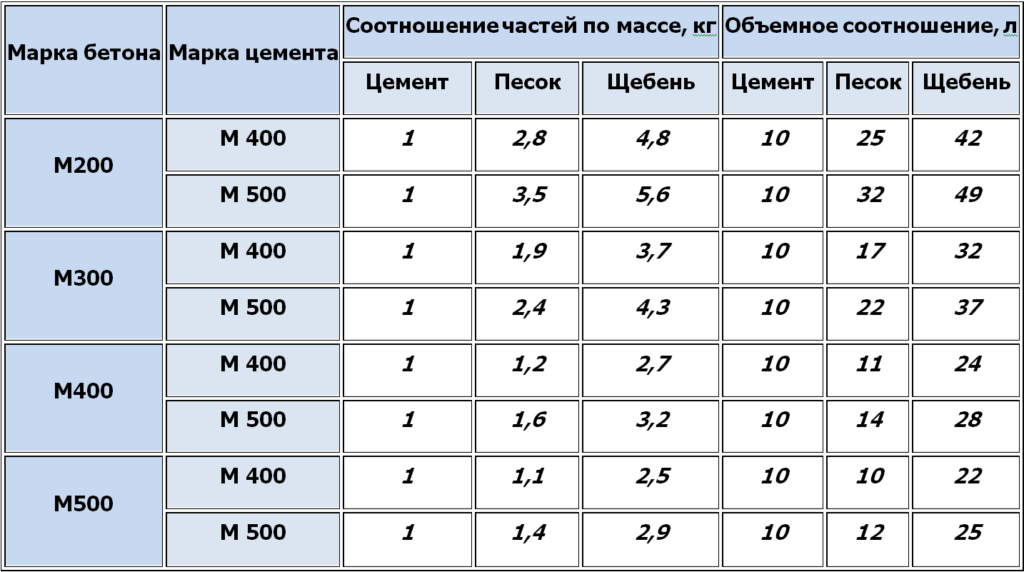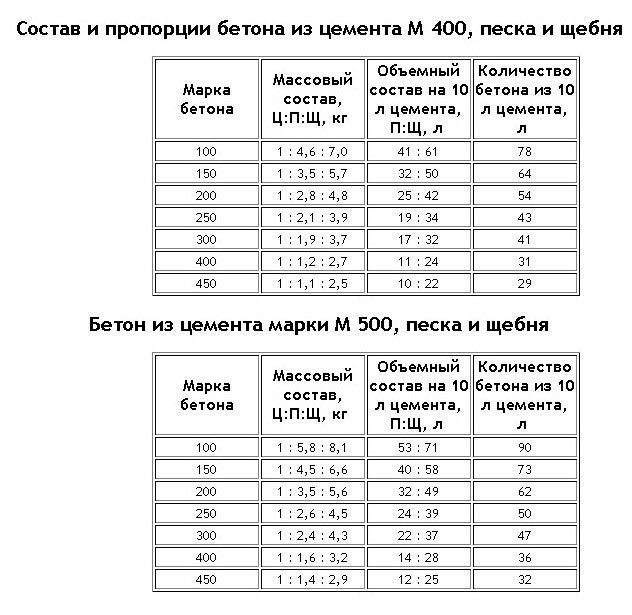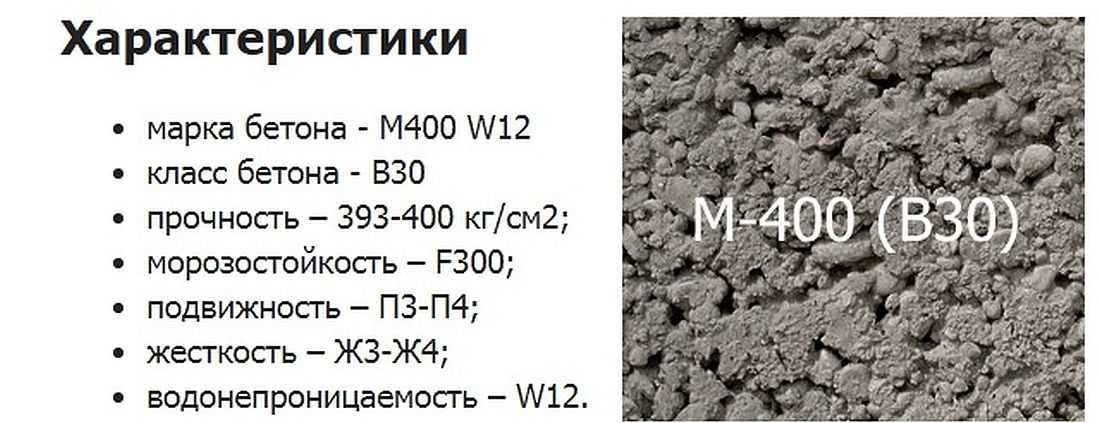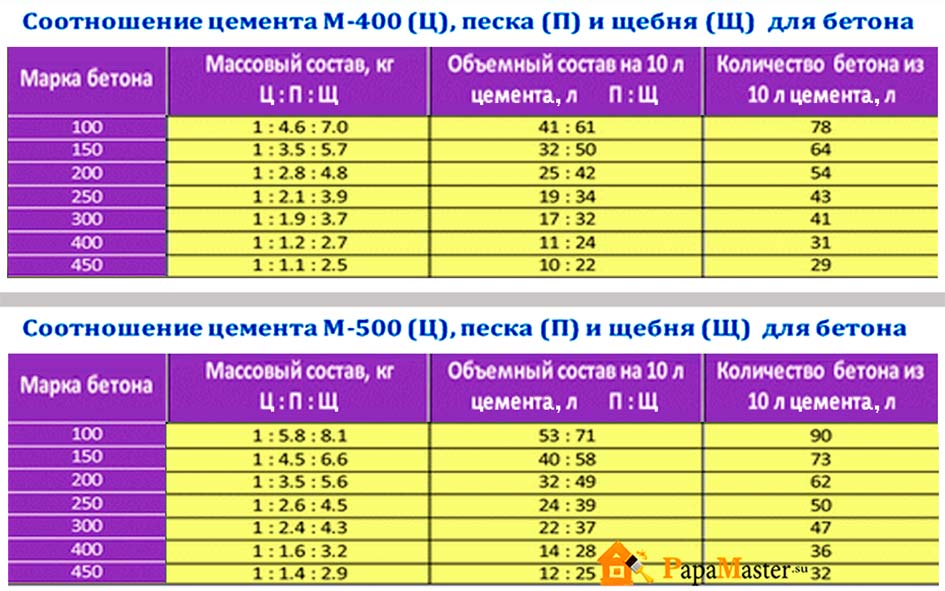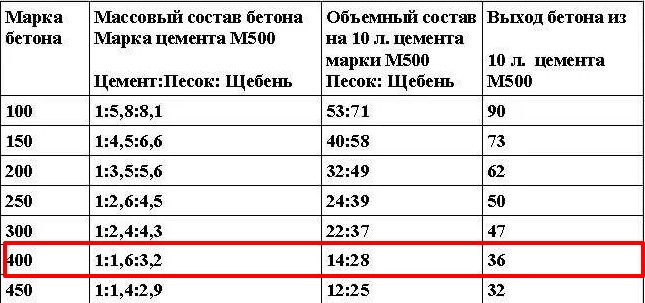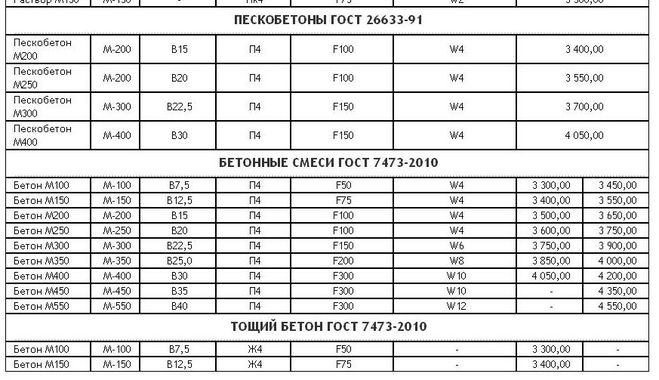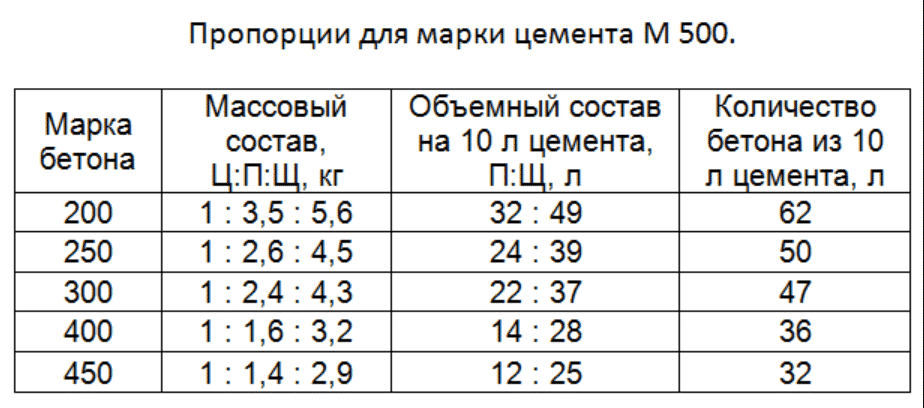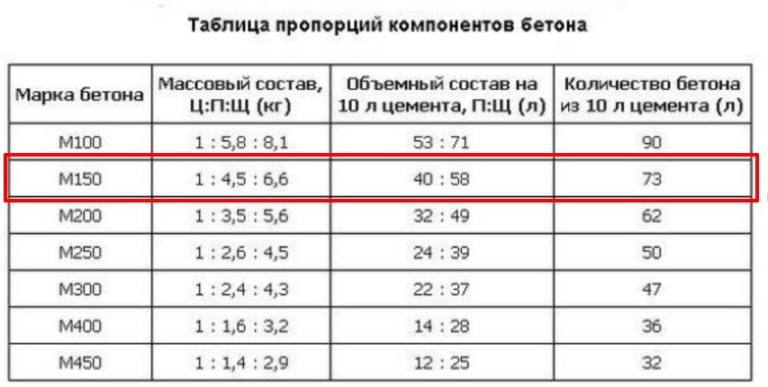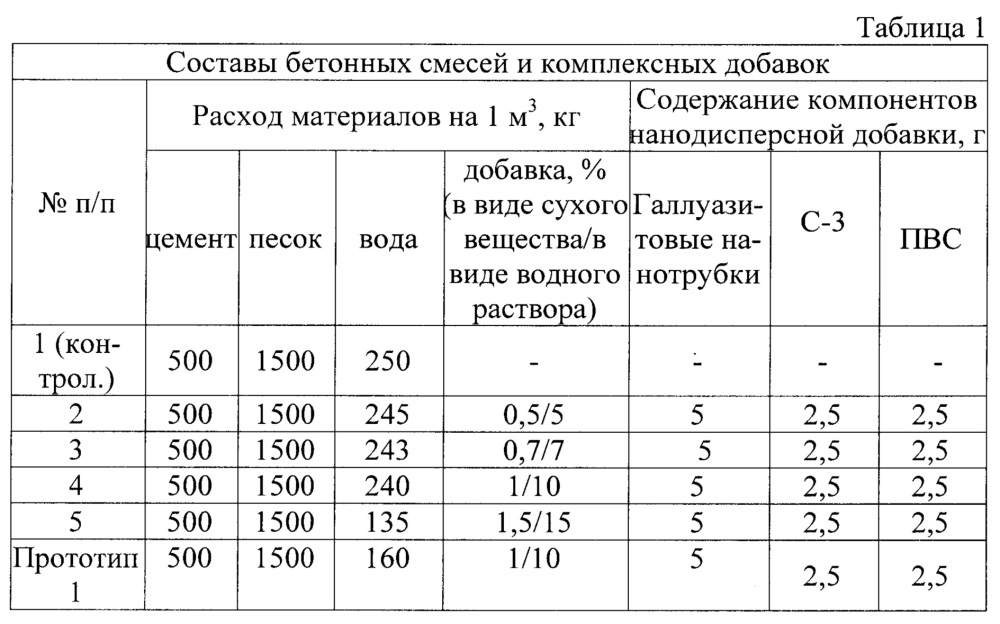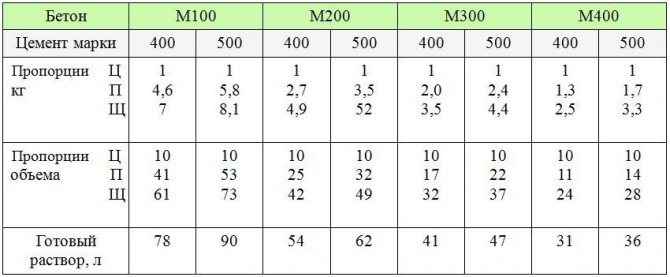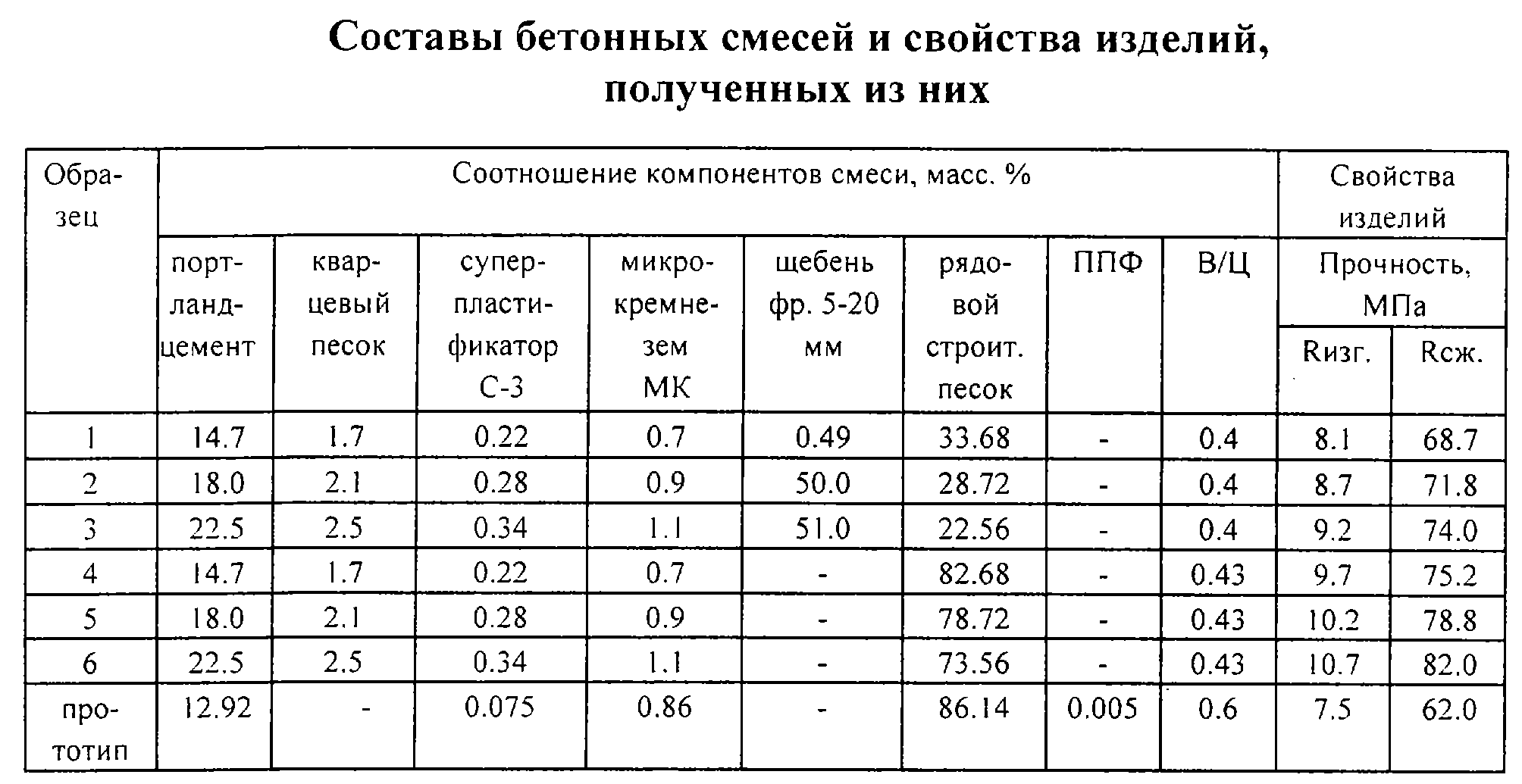Cooking proportions
For the preparation of concrete grade M400, a standard set of materials is used, which are mixed in the appropriate proportion. Cement M500 and M400 can be used in production. Depending on the brand of binder, the mass fractions of the components may vary slightly. The proportions for the production of 1 m³ of concrete solution are shown in the table:
| Cement grade | Proportions C: P: U: B | Cement, kg | Sand, kg | Crushed stone, kg | Water, l | Concrete cube weight, kg |
| M400 | 1:1,5:2,5:0,5 | 420 | 625 | 1085 | 190 | 2315 |
| M500 | 1:1,9:3:0,5 | 357 | 675 | 1085 | 190 | 2304 |
Knowing the exact ratio of the components, you can accurately calculate the amount of materials and production costs to produce the right amount of concrete. It is known that the cost of one cube of this building material is 3700-4300 rubles. This will make it possible to more accurately calculate the economic component of the project. To increase the mobility of the mixture, it is not recommended to use more water; for this, special plasticizers are used, which will require about 7.5 kg. To obtain full compliance with the declared quality, it is better to order this material at a concrete plant. At the same time, it is necessary to strictly adhere to the delivery and laying schedule of this material, since it quickly sets.
But in small or private production, volume fractions are used for the manufacture of concrete mixture. In this case, the standard bucket is most often used as a measure, the volume of which is 10 liters. In order to make one cubic meter of concrete M400, you will need the following number of components:
- Portland cement M400 - 32.3 buckets;
- Refined river or quartz sand - 41.7 buckets;
- Gravel or granite crushed stone - 80.4 buckets;
- Water without salts and organic impurities - 19 buckets.
Based on this proportion, you can find out the number of buckets for any volume of concrete. For example, to prepare 100 liters or 10 buckets of mortar, the number of buckets of cement, sand, gravel, water just needs to be divided by 10. You can mix the mortar using a concrete mixer or manually using a suitable container and a shovel. In both cases, it is necessary to achieve the most homogeneous mixture of thick sour cream consistency.
Often, portable concrete mixers are used to make concrete in private construction or in small industries. At the same time, cheaper cement M400 is purchased. A standard tank of such a mixer holds about 150 liters, but in order to avoid losses during manufacture, it is filled no more than two-thirds, which is 100 liters. To make such an amount of concrete M400 or B30, you will need to take:
- Cement M400 - 3.2 buckets;
- Sand - 4.2 buckets;
- Rubble - 8 buckets;
- A little less water - 2 buckets.
After thorough mixing, a plastic mixture is obtained, ready for use, in all respects corresponding to concrete M400. In the manufacture of this material, precise proportions are required so as not to degrade its characteristics. At the same time, you need to be aware that after complete curing for 28 days, the monolith will be resistant to processing; diamond discs and drills will have to be used to cut or drill it.
Manufacturing features
It should be borne in mind that the manufacturing process is almost identical for any type of concrete, but it is possible to make a solution of the correct consistency only if the technology is followed. The slightest violation can lead to a decrease in properties. The correct ratio of ingredients will help you make high quality b30 m400 cement. When choosing a cement mixture, you must make sure that it does not have time to absorb moisture during storage and is released for a maximum of three months. back
In addition, an important feature of concrete production is the selection of good materials. After purchasing the components, the builders begin work.
The preparation of the mixture consists of several steps:
- First, sand, cement mortar are mixed until smooth.
- Then add water. The strength of the structure depends on the amount of water. To make one cubic meter, you will need many liters of liquid.
- After that, gravel is added to the mixture and mixed thoroughly.
Concrete preparation B25
Composition
B25 concrete consists of the following components:
- Cement;
- Water;
- Crushed stone;
- Sand;
- All kinds of additives (anti-freeze or plasticizing).
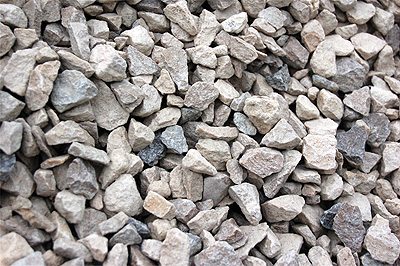
In the photo - rubble
I must say that the components used to prepare the solution may differ in strength, particle size and some other parameters.
For example, placeholders can be:
- Coarse, medium and fine-grained sand.
- Crushed stone;
- Granite or limestone gravel.
Also, from the features of this solution, an increased cement content can be distinguished, due to which the material hardens relatively quickly.
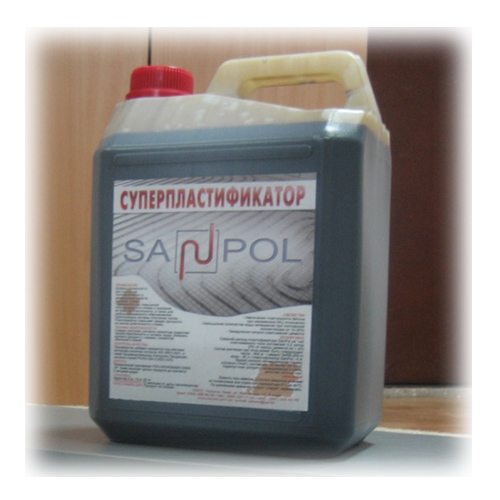
Plasticizer
Technology
The composition of the proportion of concrete M350 per 1m3 is as follows:
- 400kg of cement M500;
- 752kg of sand (cleaned from impurities);
- Ton of crushed stone or other solid aggregate;
- 175 liters of water.
To obtain high-quality concrete, it is necessary not only to strictly observe the given composition of concrete M350 per 1m3, but also thoroughly mix all the components so that the mass is homogeneous. The fact is that a poorly mixed mass significantly reduces the strength of the material, which, of course, reduces the technical and operational characteristics of the structure.
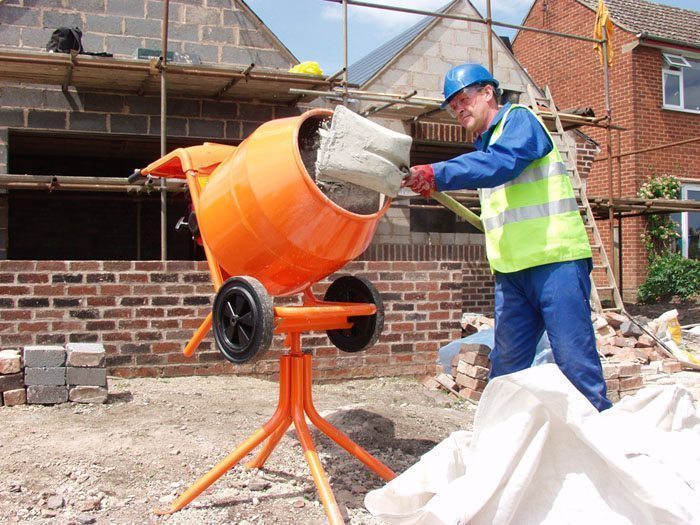
Preparation of the solution
As mentioned above, various additives can be used to improve the properties of the material. For example, if the construction is carried out in winter, then to prevent the solution from freezing, an anti-freeze additive is added to it. In addition, plasticizers can improve strength and water resistance.
The instructions for preparing the solution are as follows:
- First, dry components should be added to the concrete mixer, i.e. cement and sand. Mix the components thoroughly.
- Then water is added to the composition. At this stage, a plasticizer or other additive can also be added to the solution.
- After that, the required amount of gravel or crushed stone soaked in water is added to the concrete mixer. In this case, the solution is thoroughly mixed until a homogeneous mass is obtained.
I must say that when performing construction work, it is not necessary to prepare a solution with your own hands. There are companies that sell ready-mixed concrete.
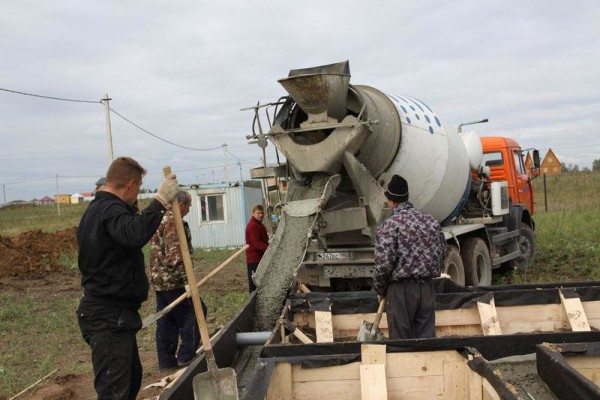
Pouring mortar from a concrete mixer
Of course, in this case, the price of the solution will be higher, but for that you will get a well-mixed mass. In addition, you do not have to waste time making it. Often, such companies also provide special equipment that simplifies the pouring process, which is convenient when performing large-scale work.
The cost of concrete M350 per cubic meter consists of the cost of the components that are used in the composition, the costs associated with its preparation and delivery, as well as the manufacturer's margin. Therefore, each company has its own market value of the material. If additives are used in the composition, for example, for frost resistance, then, accordingly, the cost of the solution will be higher.
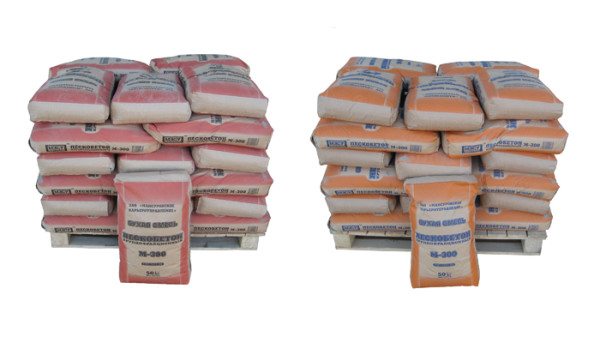
Packaged sand concrete
It should be noted that in construction stores you can buy M350 sand concrete in bags. In this case, the developer, in order to obtain a sandy solution, only needs to stir the dry mixture with water in the proportion indicated on the package. Of course, the cost of such a material is much lower than the finished solution.
These are, perhaps, all the main features of B25 concrete that you should know when choosing a material grade for concrete work.
Specifications
All requirements for the starting materials and properties of the final product are set out in GOST 26633-2012 “Heavy and fine-grained concrete. Technical conditions ". Therefore, in the manufacture of concrete grade 350, one should strive to achieve the following indicators:
Compressive strength is determined by destructive or non-destructive testing methods. In the first case, standard cubes with a size of 10 * 10 * 10 cm are made, they are kept under conditions at a given temperature and humidity regime. Then a test is carried out on a special press. The pressure at which the cube begins to collapse is an indicator of the ultimate strength. For concrete of class B25, this value corresponds to 25 MPa or 350 kg / m / cm2.
Non-destructive testing methods are usually applied to ready-made structures. For this, ultrasonic and radiometric instruments, laboratory hammers are used: old ones - Fizdel and Kashkarov or modern ones, for example, Schmidt OS-120.
- Mobility. This indicator is determined from the results of tests on heavy concrete M350 using a standard cone. If the draft of the cone is 0-10 mm, it is a rigid mixture, from 10 to 50 mm - inactive, from 60 to 140 mm - movable and over 150 mm - cast. Plasticizing additives help to regulate mobility without changing the value of the water-cement ratio.
- The frost resistance index for our concrete should be equal to F200. This means that the test samples will not change their properties, structure and integrity after 200 cycles of alternate freezing and thawing.
The list of technical characteristics of concrete M 350 is completed by the indicator of its volumetric weight, which can vary from 1800 to 2500 kg / m3. Such a breakdown depends mainly on the properties of the coarse aggregate and the raw material from which it is made. The normal and most acceptable weight value of 1m3 of m350 concrete is 2200-2400 kg / m3.
Areas of use
We decided on what materials are required for concrete in what proportions, but what brand is needed? It depends on the purpose of the structure and the conditions of its operation. It will be easier to navigate if you know which grades of concrete can be used for what (we will name only those that are used in the construction of a private house, its repair or arrangement of the site).
M100 (B7.5). This is the so-called skinny concrete. It is used to prepare the site for critical structures. For example, when building a strip foundation, a layer of lean concrete is laid on a gravel-sand bed, and then reinforcement work begins. The same composition is used when laying a curbstone, for example, in the manufacture of paths or blind areas around the house.
M150 (B12.5). This composition is used in preparation for slab foundations, for screeds, pouring concrete floors or garden paths. This type of concrete can be used to make foundations for small lightweight buildings such as a wooden bath or a small guest house made of timber or logs.
M200 (B15). One of the most popular brands of concrete. Foundations of any type are made from it for light houses on normal soils, screeds, stairs, blind areas, paths. Concrete of this brand is used to make cement blocks at home, it is also used in factories for the manufacture of foundation and building blocks.
Cement to sand ratio for concrete affects the strength characteristics
M250 (B20). The area of application is practically the same, but in more difficult conditions. Any foundations are made on difficult soils, or on normal ones, but for houses built of heavy materials. They make blind areas that will be used as paths, outdoor stairs, concrete porch, fences, etc. Also, floor slabs are made from it at low loads.
M300 (B22.5). Also suitable for all of the above areas, but in even more severe operating conditions. They make foundations for heavy houses on heaving soils, make monolithic walls, paths, a waterproof blind area, etc. This brand of concrete is mainly used to make floor slabs and grillages for pile-grillage foundations.
M350 (B25). The strength of this brand for private construction is mostly excessive.This concrete is used for the construction of monolithic pool basins or for the manufacture of foundations with a high level of groundwater, for other structures that require high water resistance. This brand is already more often used in industrial construction.
Scope of application
High-strength concrete, starting from B25, is used for prefabricated and monolithic frame elements, reinforced concrete structures of buildings - floor slabs, columns, girders, trusses and crane beams. Concrete B25 (M350) and higher classes are used for the manufacture of monolithic foundations, pile-grillage concrete structures, bathtubs, walls of pool bowls. Heavy super-strong compounds are used in road construction for the construction of bridges and tunnels. B25 (M350) concrete is well suited for the construction of airfield runways, which must withstand prolonged cyclic loads.
The use of such concrete is regulated by SNiPs and GOSTs related to work on the manufacture of reinforced concrete products. When concreting, vibration compaction must be used. To do this, when pouring prefabricated structures in the factory, stationary vibration stands or vibration platforms should be used, and for monolithic ones, vibrators with a flexible shaft should be used.
In addition to the wide use of the B25 class in industrial construction, it can be recommended for the construction of individual residential buildings.
It is necessary to prepare such a composition with careful adherence to the recipe. However, in order to prevent unforeseen and force majeure situations, it is better to order the mixture at mortar-concrete units, where input quality control of materials is mandatory, as well as verification of the resulting products. Upon delivery, the seller is fully responsible for the quality of the solution and the conformity of the characteristics.
Mix components
To prepare M200 or B15 yourself, you need to observe the proportions and choose the right ingredients.
Cement.
Portland cement M400 or M500 is suitable, but the choice will affect the proportions. Buy fresh cement, otherwise the strength will be lower.
Sand.
It is better to use river sand, as it does not need to be washed and sifted out. If you nevertheless chose a quarry, make sure that it contains a minimum of foreign particles and clay impurities. Fraction size: 1.3-3.5 mm.
Crushed stone.
In the production of class B15, gravel or granite crushed stone with a size of fractions of 10-40 mm is used. To increase the density of large filler particles, they are mixed with smaller crushed stone.
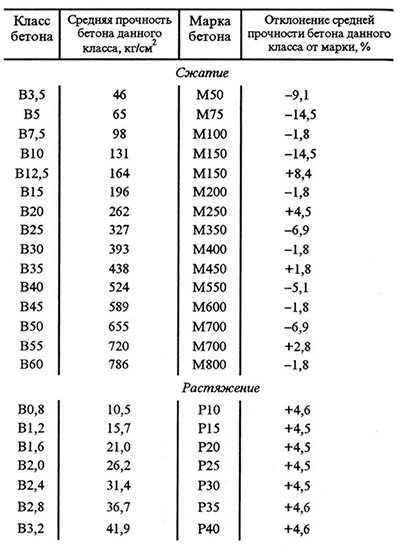
Required proportions
According to GOST, the composition of concrete per 1 m3 of grade M200 includes 265 kg of cement, 860 kg of sand, 1050 kg of crushed stone, 180 liters of water and a plasticizer, the weight of which is 4.8 kg, while the resulting material has the following characteristics: W2, F50, P3. But the frost resistance and water resistance of B15 is not suitable for foundations or other buildings in an aggressive environment, therefore, in the classic recipe for cooking on our own, the ratio of the components is slightly changed.
The table shows the proportions of aggregates and water in kilograms per 1 kg of popular brands of Portland cement. To increase water resistance and frost resistance, we recommend adding less water, since it is the excess moisture that forms voids in the mixture gaining strength. Use a vibrating compactor to increase density.
| Cement М400 | Cement М500 | |
| Sand | 2,8 | 3,5 |
| Crushed stone | 4,8 | 5,6 |
| Water | 0,5 | 0,5 |
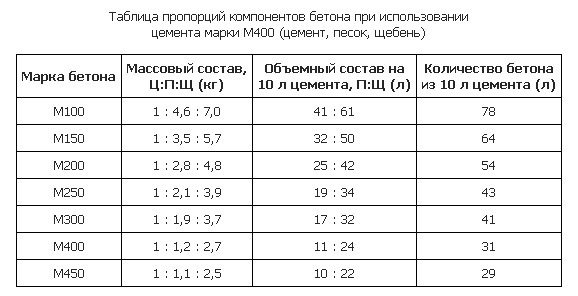
Strength gain
B15 gains brand strength only 28 days after pouring. The hardening rate depends on the ambient temperature. The recommended temperature is + 15-20. If it is higher, the concrete will have to be constantly wetted so that it does not dry out, and if the thermometer drops below 0 degrees, the water in the mixture freezes and the hardening process stops. By starting further construction ahead of time, you get concrete with lower characteristics, even if the entire composition is the same.
| Temperature of the day | 1 | 2 | 5 | 7 | 14 | 28 |
| 5 | 12 | 28 | 35 | 50 | 65 | |
| +5 | 9 | 19 | 38 | 48 | 62 | 77 |
| +10 | 12 | 25 | 50 | 58 | 72 | 85 |
| +20 | 23 | 40 | 65 | 75 | 90 | 100 |
| +30 | 35 | 55 | 80 | 90 | 100 |
Method for measuring the strength of concrete
Methods for determining the strength characteristics of the material and the requirements for control samples are established by GOST 10180-2012. To calculate the strength of concrete, it is necessary to measure the minimum force that is capable of breaking a particular specimen. In this case, the static load must grow at a constant rate.
The type of control samples depends on the method used to determine the strength characteristics.
 Methods for determining the strength characteristics of concrete
Methods for determining the strength characteristics of concrete
Other types of samples can also be used to determine the characteristics: cubes with edges measuring 7 cm, prisms measuring 7 x 7 x 28 cm, cylinders having a diameter of 7 cm. The dimensions of the control samples are interrelated with the size of the filler used in the mixture.
 The dimensions of the control samples are interrelated with the size of the filler used in the mixture.
The dimensions of the control samples are interrelated with the size of the filler used in the mixture.
Samples of concrete (mixture), from which control samples are made, are taken from the working composition of the concrete mixture. The solution is poured into calibrated molds, previously treated with lubricant from the inside. It should not change the characteristics of the surface layer of the control product. Compaction of the mixture is carried out by bayonetting, using a vibrating plate or a deep vibrator.
 Vibrating platform
Vibrating platform
Sample hardening modes differ depending on the technology used in the production. If natural hardening is used, after production the samples are stored at 20 ± 5 degrees in molds covered with the material to prevent moisture evaporation. Deforming of products is performed after 24 ... 72 hours (when examining the compressive strength) or after 72 ... 96 hours (when determining the tensile strength). Then the samples continue to harden at a temperature of 20 ± 2 degrees and a humidity of 95 ± 5%.
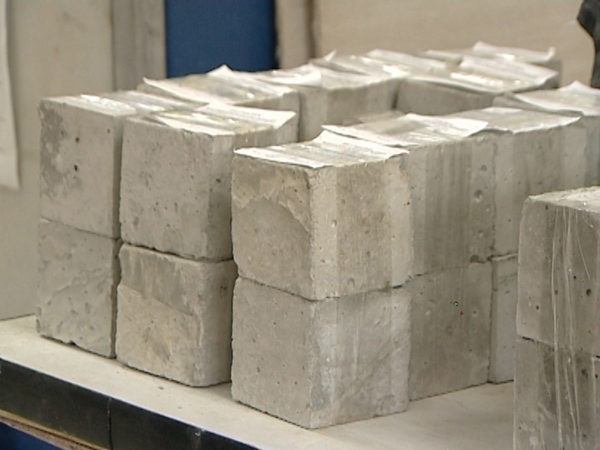 Testing concrete samples
Testing concrete samples
Control samples, which are expected to harden under the influence of heat, are placed (in molds) in special units: an autoclave, a steaming chamber, etc. After processing, the samples are freed from the formwork and stored under normal conditions or sent for testing.
Testing
To determine the compressive strength, the samples are placed between the plates and a constantly increasing load of 0.6 ± 0.2 MPa / s is applied to them (until fracture).
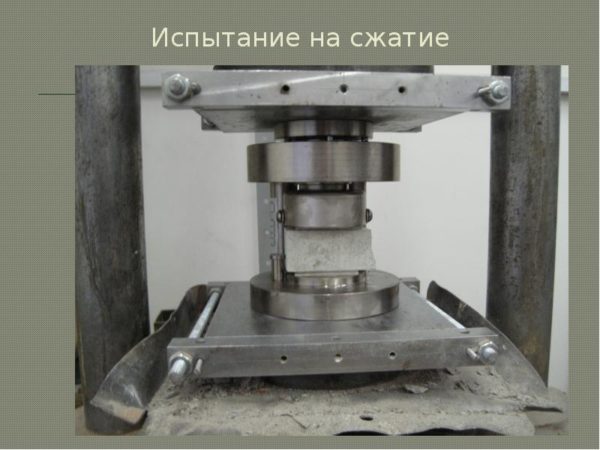 Compression test
Compression test
Testing of samples for tensile bending is carried out in testing machines using an increasing load of 0.05 ± 0.01 MPa / s.
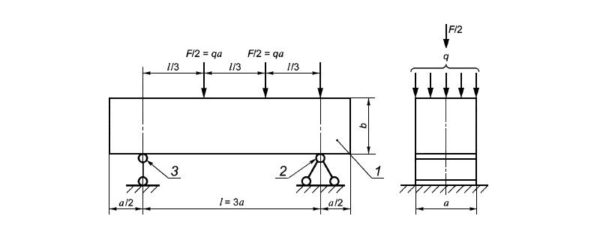 Concrete resists compression well and poorly resists stretching
Concrete resists compression well and poorly resists stretching
The splitting tensile test is performed on the plate of the testing machine. The test is carried out at a constant rate of load rise (0.05 ± 0.01) MPa / s.
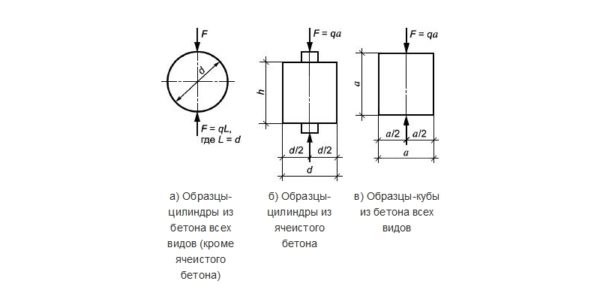 Samples of various types of concrete
Samples of various types of concrete
The axial tensile test is carried out using a gripper system at a constant rate of load rise (0.05 ± 0.01) MPa / s until the sample fails. After the experiments, the strength of the samples is calculated. All data is recorded in the test log.
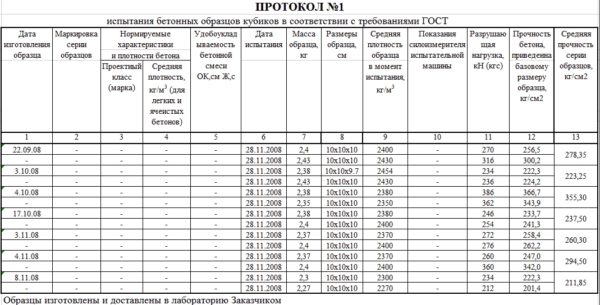 Example of a test report
Example of a test report
Tests are carried out for each batch of products or designs.
What is concrete, its varieties
Concrete, which has been used for construction purposes for several thousand years, is classified as an artificial material. It is made from several components: a binder, aggregate, water and additives that improve performance, and goes through the stages of molding and hardening.
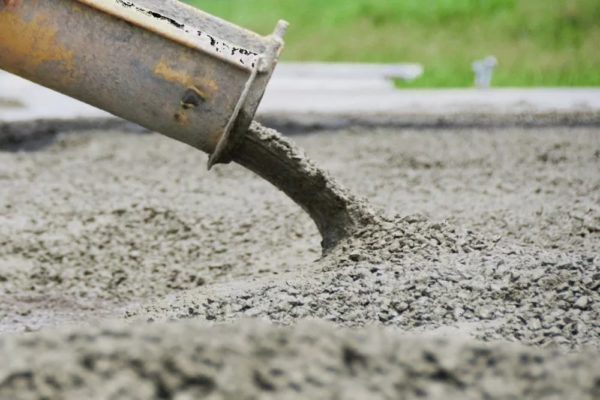 Concrete grade and concrete class
Concrete grade and concrete class
Concrete is a versatile material, its scope of use is extremely extensive. It is actively used in the construction of buildings, fences, bridges, roads, other types of structures, as well as individual products required in construction and decoration.
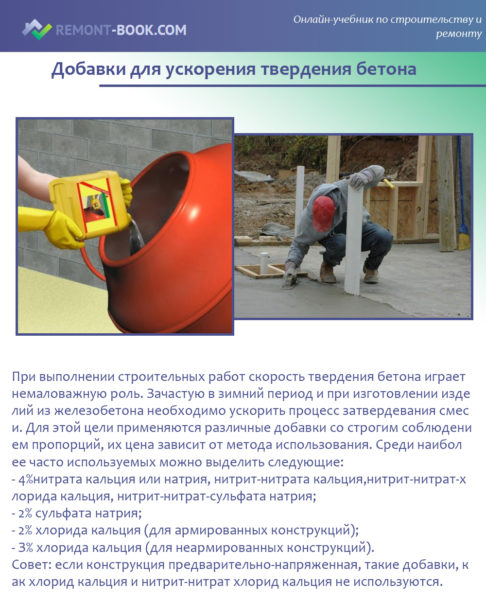 Additives for concrete hardening
Additives for concrete hardening
Concrete types
Today, many types of stone materials are produced, which are regulated by GOST 25192 * 2012, which can be used in various construction areas.Concrete is classified according to several criteria. Depending on the purpose, it can be structural or special. Natural conditions or heat treatment can be used for hardening. The material also differs in terms of abrasion, frost resistance, water resistance.
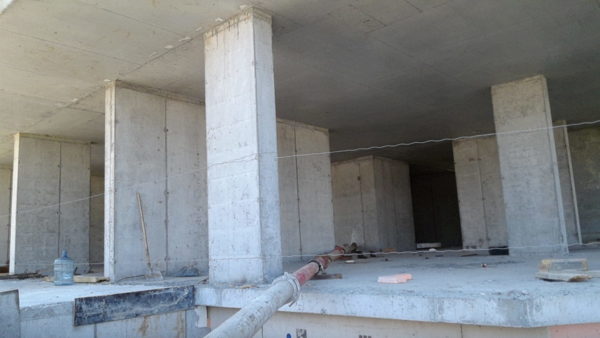 Structural concrete
Structural concrete
Table. Concrete grades depending on characteristics.
| Degree | Abrasion | Frost resistance | Water resistance |
|---|---|---|---|
| Low | G1 | Up to F50 | Before W4 |
| Average | G2 | F50 ... F300 | W4 ... W12 |
| High | G3 | From F300 | From W12 |
Several more varieties of material are classified according to a number of characteristics.
Density of concrete
Depending on the density, a distinction is made between especially light, light, heavy and especially heavy artificial stone. Where various varieties are used is clearly shown in the photo.
 Concrete classification table
Concrete classification table
Binder type
The most common material is cement based. It is often called cement concrete. Also as a binder can be used: gypsum, lime, slag or polymers.
 Why cement-concrete roads are better than asphalt-concrete ones
Why cement-concrete roads are better than asphalt-concrete ones
Placeholder type
For the production of concrete, dense, porous and special components are used. Depending on the type of aggregate, the following types of building materials are produced:
- heavy (the main components are cement, as well as dense coarse and fine filler);
- fine-grained (it uses dense fine aggregate);
- wood concrete (organic matter is used as a filler: wood chips, rice straw, etc.);
- soil concrete (a component of the mixture is crushed or granular soil);
- ash concrete (in lightweight concrete, ash is used as a filler);
- polymer concrete (the composition includes polymers and monomers), as well as some other varieties.
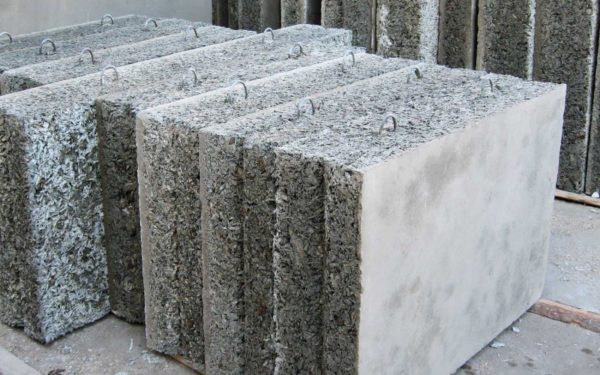 What is arbolite
What is arbolite
Structure
According to the structure of the material, the following types can be distinguished: dense, porous, cellular and large-porous.
Macrostructure of concrete
In addition, concrete can be reinforced (reinforcing bars or mesh are placed in its body to increase strength). Fiber concrete is also produced. In the manufacture of this material, small fibers (fiber) are used, which can be made from steel, polypropylene, cellulose, basalt, polyamide, etc. Such inclusions can significantly increase the strength characteristics of an artificial stone.
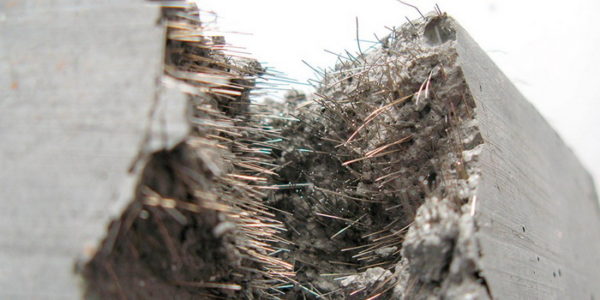 Fiber concrete structure
Fiber concrete structure
Scope of application
Concrete grade B25 is used in construction quite widely - both in private and in industrial. Usually it is used where it is necessary to provide high strength and good resistance to various influences, durability.
Where 350 grade concrete is used:
- Creation of foundations for multi-storey and large houses: pile-grillage, monolithic
- Slabs ebb for airfields, roads with high loads, high exploitation
- Formation of columns to be used to support slabs
- Creation of reinforced concrete structures of various types
- Filling slabs with low weight due to voids, but with increased strength indicators
- Forming pool bowls
- Dealing with structures located where groundwater rises too high
- Building elements of various types - crane beams, trusses, crossbars, floors, etc.
- Construction of tunnels, bridges
- Arrangement of runways of airfields with serious cyclic loads
The technical characteristics of concrete M350 allow it to be used wherever it is necessary to achieve resistance to water and other negative factors and to ensure the strength, reliability, and long service life of the structure.
The composition and proportions of the components of the mixture
The popular concrete M150 includes standard components - Portland cement, sand, crushed stone, water.Due to its simple composition and ease of manufacture, it is produced not only in industrial conditions, but also independently, directly in private construction. The main condition that must be observed when preparing concrete of the M150 brand is thorough mixing, in compliance with all proportions in accordance with the approved GOST standards. In this case, the properties of the solution can vary within certain limits due to the difference in the properties of the fillers.
For the manufacture of concrete grade M150, Portland cement of grades M400 and M500 can be used. The mass proportions of the components are determined from the following table:
| Portland cement brand | Mass proportions
cement: sand: crushed stone |
| M400 | 1:3,5:5,7 |
| M500 | 1:4,5:6,6 |
From this, we can make the obvious conclusion that the higher, the less it will be required for the concrete mixture, but it must be borne in mind that cement of a higher grade will cost more.
In private construction, mixing of the solution is often done manually, and the volume of the components is measured in buckets. Considering that the volume of a standard bucket is 10 liters, then for such an amount of Portland cement of the M400 brand, 32 liters of sand and 50 liters of crushed stone will be required, as a result, after thorough mixing, you get 64 liters of solution. For 10 liters of M500 Portland cement, 40 liters of sand and 58 liters of crushed stone will be required, and the output will be 73 liters of the mixture. For better styling, plasticizers can be added to the mortar.
In the industrial production of concrete, the composition is calculated on the basis of 1 m³ of the ready-made mortar, taking into account the strength and mobility class of the mixture, water resistance and frost resistance, which are indicated by the corresponding indices. The ratio of the components per cube of concrete can be seen in the corresponding table:
| Mix parameters | Proportions of components per 1 m3 of concrete, kg | ||||
| Cement | Sand | Crushed stone / gravel | Water | Additive | |
| B10 P3-P4 | 210 – 230 | 780 – 850 | 1170 – 1190 | 150 – 180 | plasticizer |
| B10 P3-P4 W2 F50 | 230 – 240 | 750 – 850 | 1170 – 1190 | 150 – 170 | plasticizer |
| B12.5 P3-P4 W2-4 F50 | 240 – 260 | 700 – 800 | 1150 – 1190 | 150 – 170 | plasticizer |
Portland cement can be marked with I 32.5N or I 42.5N, in this case the proportions for the manufacture of concrete mortar M150 and the number of components for the manufacture of 1 m³ of material can be found in the table:
| Cement grade | Proportions, kg
C: P: U: V |
Cement, kg | Sand, kg | Crushed stone, kg | Water, l |
| I 32.5H | 1:3,4:5,4:0,9 | 215 | 735 | 1140 | 190 |
| I 42.5H | 1:4:6:1 | 190 | 755 | 1140 | 190 |
When preparing the mortar, it is recommended to wet the mixer in advance to avoid overspray of cement. After that, the ingredients of the solution are loaded and thoroughly mixed for at least 5 minutes, the lower the mobility of the mixture, the longer the solution needs to be mixed. Dissolved plasticizer is added if necessary.
To obtain a quality solution, it is necessary to ensure that the fillers meet certain requirements. Sand can be only riverine or washed without the inclusion of foreign components, fraction 1.5-2 mm. It is recommended to use gravel or crushed limestone with a fraction of 5-20 mm as a coarse filler. The water used in the preparation of the solution should not contain mineral or organic impurities.
Concrete of the M150 brand is one of the most common materials in construction. It does not have increased strength characteristics, it has high water permeability and average frost resistance, which is attributed to its disadvantages. At the same time, it is one of the cheapest materials, so it can be used in maximum volumes. Upon completion of hydration, the concrete structure acquires the declared technical characteristics, which remain for many years. In cases where significant volumes are required, for pouring a pillow under a foundation or other work, it is more profitable to order a mixture from specialized factories. They purchase materials in large quantities at a wholesale price, which has a positive effect on the final cost of the product. In this case, it is necessary to require a quality certificate for the material provided, its compliance with GOST.
Technical characteristics of sand concrete M300
The composition of sand concrete M300 includes two main components: Portland cement and sand.Plasticizers and modifiers are also added to it. This is a dry mixture, in which, in addition, during the preparation of the solution itself, you can add a water repellent for concrete, which will improve the waterproofing qualities of the entire solution.
In this case, the proportions of the components are in the ratio: one third is cement, two thirds is sand. For a mixture of sand concrete M300, cement of the M500 brand is used
It is necessary to pay attention to what kind of sand was used to make the mixture.
If it is coarse, then the mortar is used to fill the foundations. If fine-grained, then for screeds. Consider the main technical characteristics of the sand concrete mixture.
Compressive strength
This is the main characteristic of any concrete, because building structures are constantly subjected to static and dynamic loads. If the tensile strength is less than the value of the loads, this will lead to destruction.
So, M300 solution can withstand 30 MPa, where 1 MPa is 9.81 kg / cm². For convenience of calculation, this value is rounded up to "10". Therefore, for example, a screed poured onto the floor will withstand a pressure of up to 300 kg / cm². This is a fairly durable surface.
Frost resistance
This is another important characteristic of M300 concrete, especially if it is used for pouring floors in unheated rooms. For example, in the garage. According to GOST, it is determined that this mixture can easily withstand 50 freezing and thawing cycles. In principle, such a floor will be in perfect condition for 50 years.
Adhesion
The adhesion properties of sand concrete are very high. In principle, it adheres well to almost any base material on which it is poured. At the same time, it creates a pressure on the base in the range of 4 kg / cm². Manufacturers recommend preparing the base before applying, as required for pouring the screeds.
Temperature Range
All concrete solutions are recommended to be poured in the temperature range from +5 to + 25C. Sand concrete of the M300 brand was no exception. Of course, situations on construction sites are different, and often builders have to carry out concrete work even at sub-zero temperatures.
Therefore, in such cases, it is necessary to add frost-resistant additives to the mixture. After that, concrete can be poured even at -15C.
Bulk density
In construction, they operate with this very indicator. This is the density of the dry material, which takes into account both the volume of the particles of the ingredients in the mixture and the space between them. In the bag, sand concrete is in just such a state. And its density is 1500 kg / m³.
You can make a reverse translation of the dependence of weight on volume, it will be equal to 0.67 m³ / t. So it is convenient to calculate the consumption of sand concrete when it is poured in buckets (10 liters). One bucket contains 15 kg of mass.
Solution consumption
This indicator of consumption is of interest to consumers most often, because the cost of money depends on it. It is measured by the amount of material laid on 1 m² of surface at a thickness of 1 cm (10 mm).
Depending on the manufacturer, the consumption varies in a fairly wide range: 17-30 kg. For example, if the screed is poured with a thickness of 5 cm, then the consumption will be 85-150 kg / m². For pouring foundations, a flow rate of 1 m³ is used, it is 1.5-1.7 t / m³.
Delamination
Private developers do not pay attention to this characteristic. But she talks about the connectedness of the lower and upper layers, how strong this connection is
For mixtures of this class, the delamination is only 5%. If the manufacturer indicated this value, then the sand concrete complies with GOST.
Other characteristics
- The color of the dry mix is gray.
- The pot life of the finished material is 2 hours.
- Humidity in bags 0.2%.
- Recommended thickness of the screed or plaster layer: 10-100 mm.
- The setting time of concrete is 24 hours.
- A set of brand strength (final hardening) after 28 days.
- Container - 50 kg bag.


